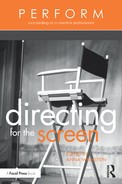INDEPENDENT FILMMAKING
In 1969, Dennis Hopper’s Easy Rider and John Schlesinger’s Midnight Cowboy rolled out the “indie movement” in the United States, producing alternative feature films outside the traditional studio system. Unshackled by box office economics, independent filmmakers were telling new stories in new ways, which often challenged audiences and critics.
By the time Francis Ford Coppola made The Rain People (1969) and George Lucas founded Zoetrope Studios (1971), the term independent film became synonymous with film school. The film departments of University of California, Los Angeles (UCLA), University of Southern California (USC), and Tisch School of the Arts (NYU) were providing the education for a new cohort of filmmakers who would dominate the independent film industry. By the 1980s, graduates such as Jim Jarmusch and Spike Lee dominated the independent film hall of fame, elevating the status of film education to a prerequisite for the “indie” industry.
By the 1990s, mainstream studios started realizing the commercial potential of independent film. Big media empires acquired smaller independent production houses or invested in their own independent subsidiaries. Miramax and Working Title Productions started to dominate the commercial market. The Sundance Film Festival unleashed Quentin Tarantino, Steven Soderbergh, David O. Russell, and Paul Thomas Anderson. In 1994, Pulp Fiction was a massive pop culture success, and by 1999, the low-budget horror film The Blair Witch Project would blur the line between reality and fantasy via its Internet marketing campaign.
While the appeal of independent film increased during the 1990s, the opportunities for independent filmmakers declined. The leap from short film to first feature was more difficult than ever. Film schools were graduating more students than the commercial and alternative industries could support, and suddenly it became much more difficult to achieve the dream of becoming the next Quentin Tarantino or Spike Lee.
And this still holds true today. To become an independent filmmaker in today’s market, you need to be prepared to invest heavily in your dreams, with modest returns. In 2014, Filmmaker Magazine reported that it would cost an independent filmmaker $119,112 to have a four-year film career—and that’s if you’re lucky enough to find investors to finance development, production, and distribution costs.1 Even if you are lucky enough to eke out a basic living from the film proceeds, it might be a long time between films.
Baz Luhrmann, renowned Australian director of Moulin Rouge! (2001) and The Great Gatsby (2013), wasn’t always directing big budget films with stars in the lead roles. In the 1980s, he struggled to make Strictly Ballroom (1992), living in student rentals and churning out draft after draft of his script. He was passionate about his story and had the perseverance to continue during those lean years, despite the odds.
This essay is about people like Luhrmann. It’s a collection of stories about today’s independent filmmakers—tales of inspiration, passion, and perseverance. I will introduce you to Shirley Barrett, another Australian filmmaker who went straight from film school to winning the Camera d’Or in Cannes. We’ll visit Singapore to explore the career of NYU Tisch graduate Ken Kwek, a Singaporean who began as a writer who bravely fought a censorship ban at home with his first feature film, and went on to win international awards and critical acclaim. Finally, we’ll go behind the scenes of a horror-thriller to learn how director Jennifer Kent—who began her career as an actress—shunned film school to make it big in the independent horror genre. These three case studies paint the new canvas of independent filmmaking today.
From Film School to First Feature
Let’s begin by looking at the film school route. In the 1970s to 1980s, students at the Australian Film and Television School (AFTRS) learned through practice, making a short film or two per year over a three-year period. When they produced their final graduate film, there was a chance these shorts would be selected for festivals or nominated for awards. In 1973, Gillian Armstrong’s graduate film, One Hundred A Day, won an Australian Film Industry award; Jane Campion’s short student films Peel (1982), Passionless Moments (1983), and Girl’s Own Story (1984) won critical acclaim internationally; and in 1988, Shirley Barrett’s Cherith won at the Sydney Film Festival and Australian Film Institute awards.
Prizes and festival screenings for short films attracted interest from local producers keen to back the graduates’ first feature film. By 2000, this blueprint translated to four feature films by AFTRS graduates at the Cannes Film Festival: Armstrong’s My Brilliant Career (1979), Campion’s Sweetie (1989), Jocelyn Moorhouse’s Proof (1991), and Barrett’s Love Serenade (1996).2 And the end of the millennium inked the formula of “film-school to first feature” into Australian film legend.
Does this formula still work today?
In May 2013, at a talk to NYU film students in Singapore that I attended, the celebrated independent filmmaker Spike Lee was asked if he would still go to NYU today.3 He responded that today, in a world of affordable digital cameras and editing software, the $75,000 course fee is a considerable investment in a short film budget. The availability of affordable digital cameras, desktop software, and mobile distribution channels empower budding directors to tell their stories without the need for a film education. And while one can’t dismiss the option of film school outright, more and more filmmakers around the globe are choosing alternative routes to independent film.
From Screenwriting to First Feature
Singaporean filmmaker Ken Kwek graduated from NYU’s Dramatic Writing Program in 2010. A former journalist, he gained a reputation as a political risk-taker after publicly accusing Singapore’s former prime minister of generating political fear.4 Frustrated with journalism, Kwek turned to creative writing to disseminate his social messages for the stage and screen. As a screenwriter, he worked with established film directors such as Glen Goei and Kelvin Tong, but he ultimately decided that directing a film would help sharpen his cinematic skills. As he said in a 2014 interview with TimeOut Singapore, “I never started out wanting to be a director, but after writing four features, I felt the itch to explore new aspects of the craft. Plus, I thought that directing would make me a better writer.”5
Kwek’s Sex, Violence and Family Values (2012) is a collection of three short films about sociopolitical issues facing Singapore.6 It was critically acclaimed at overseas festivals and screenings. Porn Masala, the second short in the anthology, won the Audience Choice Award at New York’s Gotham Screen International Film, but it would prove the most problematic. Cathay Cinemas acquired the trilogy for a theatrical release in Singapore—however, a few days before the premiere, the government revoked its M18 classification. It banned all screenings in a historical decision to rate it “Not Allowed For All” (NAFA), following complaints of racial jokes “demeaning and offensive to Indians.”7
The ban sparked an international debate about the representation of race and freedom of expression in the island state, and Kwek believes it has been an important learning experience. This tension created by the nexus of censorship and social commentary encouraged him to make his second film, Unlucky Plaza (2014). As described by The Hollywood Reporter, Unlucky Plaza is the story of an immigrant “fighting for a stake in his adopted country only to find himself shafted from all directions.”8
From Acting to First Feature
Another route as an alternative to film school is to “shadow” an established filmmaker—or in other words, to find a mentor. When Australian actress Jennifer Kent decided to embark on a career as a film director, she requested an attachment with Danish director Lars von Trier on the set of Dogville (2003). After seeing Dancer in the Dark, she was inspired to reach out to von Trier. As she said in an interview with The Guardian, “I got his address and wrote him a really heartfelt email about why I wanted to come and learn from him. I said I’d rather stick pins in my eyes than go to film school.” She described her experience on the set of Dogville as her film school.9
This overseas experience transformed Kent’s perception of filmmaking. She spent time in Paris writing scripts and found creative influence in German Expressionism. “I loved how those filmmakers took the mind and the psychological reality and put it into the space,” she said, in an interview about her film The Babadook. “That’s what I aimed to do with this film but in a contemporary way.”10
In 2005, Kent returned to Australia where she directed a short horror film, Monster, which was the genesis for The Babadook idea. But she struggled to get the support for the feature-length movie. “My scripts were too out there,” she said, “and Screen Australia said they were too ambitious financially, so I needed an idea that was contained and more intimate, and this idea of facing your shadow-side is my myth, something I think is really important in life.”11 In 2010, Kent applied for a coveted place at the Binger Filmlab in the Netherlands to develop The Babadook feature more fully.
Kent believes her international experience also influenced the production of her feature film. Adopting von Trier’s concept of a “family of collaborators,” a group of like-minded people, she hired a Polish director of photography (DP) and an American illustrator to complement her Australian crew.12 Indeed, the horror art-house psychological thriller resonated with global audiences. The Babadook debuted at Sundance Film Festival in 2014 and had theatrical releases in the United Kingdom, United States, Thailand, France, Germany, and Italy, contributing to a total overseas gross of more than $5.7 million.13 The film scored 98 percent on Rotten Tomatoes and 86 out of 100 on Metacritic ratings. The success of the film has resulted in Kent being offered films by two US studios, both of which she turned down to make another independent feature in Australia.14
New Sources of Film Development
The Binger Filmlab in Amsterdam, where Kent landed with her project, has a long list of successful independent feature films. Binger is one of many international development labs, and the list is expanding daily. While these development labs are competitive, the success rate is hard to debate.
The success of the Sundance Labs is legendary, of course, and new international labs also provide a hothouse environment for the independent filmmaker, offering a range of services from mentorship to script readings to introductions to studio executives. Kent is a strong advocate of Binger: “It really gave me the freedom to just dream a bit on it [The Babadook] without having to put it into a formulaic script format. It really benefited from that early development overseas.”15
But The Babadook hit roadblocks at the production stage. Kent’s initial application for funding was rejected. After slashing the budget and several resubmissions, she finally secured around $2.5 million in Australian funds from Screen Australia and the South Australian Film Corporation (SAFC), but this wasn’t enough money to start principal photography. There was also no money for set design, so Kent started a Kickstarter campaign for the art department, raising $30,071 in Australian dollars.
While crowdfunding is often a good option, it’s not 100 percent reliable. Film projects only have a 43 percent success rate of raising their targets, with short films more likely to hit their goal than features.16 Even Kent admits it was tough. As she told Filmmaker Magazine,
It was a nightmare, like every film is! But it happened and we got it made. I get the feeling it’s really hard to make independent films in America. We have government money here in Australia that definitely helps.17
Kent finally shot The Babadook in 2013, and it released in cinemas in 2014 after almost a decade of development.18
Limited funding is a constraint across most independent film productions around the world. Ken Kwek’s Sex, Violence and Family Values was made on a paltry budget of $80,000, shot over a period of twelve months, shooting after hours at the producers’ nightclub, with friends and acquaintances helping out as cast and crew. His second feature, Unlucky Plaza (2014), was made on a low budget of $565,000, which he raised from private investment.
A Stephen Follows survey of 542 film professionals who have attended Cannes in the years 2010 to 2015 determines $396,000 as the maximum budget for a “micro-budget” film, while the maximum budget for “low budget” films is $2.1 million.19 Ironically, funding for independent feature films is lower in Australia today ($3.5 million Australian dollars) than what it was in the 1990s, when Shirley Barrett made her first feature Love Serenade (1996) for $3.8 million Australian.
When Hollywood knocks …
Shirley Barrett made her first feature film nearly a decade after graduating from film school. The screenplay for Love Serenade attracted the interest of producer Jan Chapman, who had just risen to global prominence with Jane Campion’s feature The Piano (1993). The film was financed through a complex nexus of government and private investment, and shot in rural Australia with relatively unknown actors. Critics applauded the film for its clever yet quirky, laconic comedic style.
Although the film met with critical acclaim in Australia, it didn’t hit its target box office returns at home until it won the prestigious Camera d’Or in Cannes in 1996. The win turned Barrett’s life around. She fielded offers from Hollywood, including the opportunity to direct American Beauty and Erin Brokovich, but she turned down the US studios. As she said in an interview with The Sydney Morning Herald:
I was not competitive enough… . America scared me and I did not want to uproot a young family. At that time there was no supportive community of Aussies there, unlike now, so it was even more daunting… . I thought other offers would come, but they didn’t.20
Instead of going Hollywood, Barrett decided to take a $5 million offer from US producer David Geffen to fund her next film project in Australia with the freedom to realize it according to her own vision. This allowed her to write and direct her second feature film, Walk the Talk (2000).21 But unfortunately, the film “fizzled” at the box office, and Barrett learned the hard way that “once you are off the radar … there are no Christmas cards with studio logos, no phone calls checking to see if you’re still available.”22

Cannes-winning director Shirley Barrett
Photo by Karl Schwerdtfeger. Copyright: Pan Macmillan Australia
These days, Barrett stresses the importance on capitalizing on your successes:
I tell film school students that when there’s a lot of interest in your work, you really have a short window of time [to take advantage]. The smarter folk went overseas to seize that opportunity [and] I guess have got much more of a career than me.23
Despite making a third feature, South Solitary (2010), Barrett told The Herald that she is “reconciled to never making another film,”24 and she has recently turned her hand to writing novels. Her bread and butter work is directing primetime television drama and the successful release of her novel Rush Oh!, which is based on a film idea that never made it to production.25
The independent film movement, while hardly fifty years old, is a rapidly changing genre. Since the days of Easy Rider and Midnight Cowboy in the late 1960s, analogue technology has given way to digital media, brick and mortar film schools are being replaced by film labs, and local film screenings have evolved into an explosion of websites and global festivals.
But some things will never change. To get your foot in that door, you still need to learn the ropes—whether that’s through school, internships, or simply picking up a camera yourself. And you can’t get too much experience—not only in independent film, but in any of the associated media fields. The industry has never been so interdisciplinary, with tangential connections that have the ability to open hidden doors.
But most of all, you need a strong belief in yourself and the stories you want to tell. Look far and wide for support and universality—it’s a global playing field today, and your audience is beyond your back door. Look for innovative ways to get your project off the ground—film labs, crowdfunding, angel investors (even if it’s friends and family)—and you might just find collaborators who will defer payment and co-producers who won’t curb your creativity but instead will help get your ideas to the screen.

Pieter Aquilia
